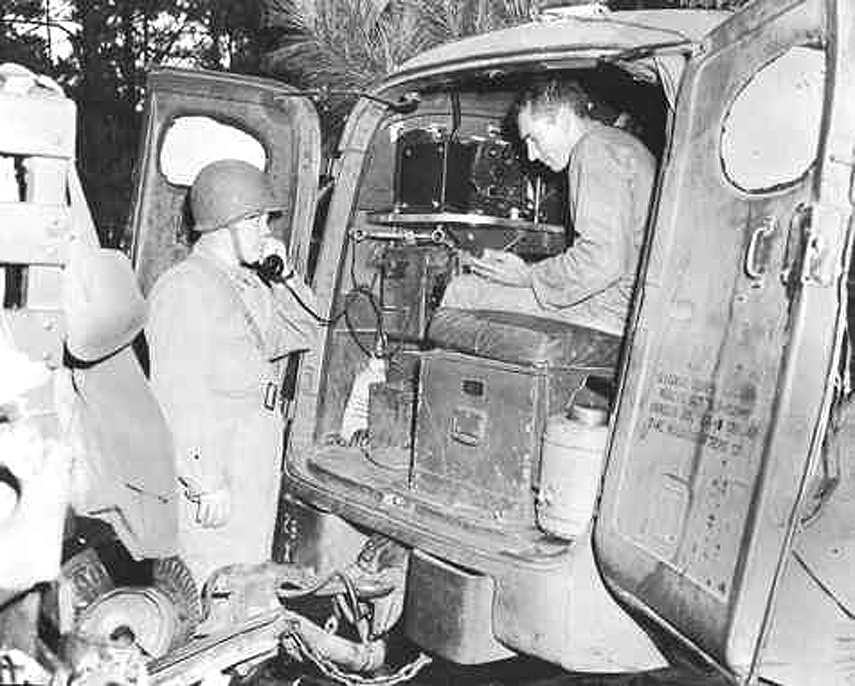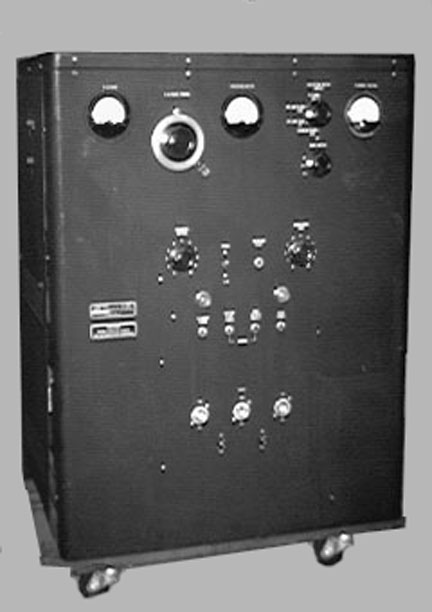|
SCR-299
The SCR-299 was a U.S. Signal Corps mobile military communications unit used during World War II. History The SCR-299 "mobile communications unit" was developed to provide long-range communications during World War II. The US Military sought improvements of range, flexibility and durability over its existing SCR-197 and SCR-597 transmitters. In 1942, Hallicrafters Standard HT-4 was selected as the SCR-299's transmitter, known subsequently by its military designation as the BC-610. The SCR-299 was first used on November 8, 1942 during Operation TORCH involving companies of the 829th Signal Service Battalion establishing a radio net that could exchange messages between beach-landed forces and bases in Gibraltar. Despite initial problems unloading the sets from convoy ships, the SCR-299s served until the installation of permanent Army Command and Administrative Network stations. According to US Army military historians, "General Dwight Eisenhower credited the SCR-299 in his successful ... [...More Info...] [...Related Items...] OR: [Wikipedia] [Google] [Baidu] |
BC-610
The BC-610 was a radio transmitter based on the Hallicrafters HT-4 and was used by the U.S. Army Signal Corps during World War II. History In the early 1940s, the U.S. military sought a high-powered radio transmitter capable of infallible voice communications over 100 miles (160 km), sturdy enough to work in all conditions, flexible enough to be able to cover a wide range of frequencies, self-powered and able to operate in motion or at fixed locations. The Hallicrafters HT-4 transmitter was chosen from units available from various U.S. radio manufacturers. The HT-4 was designed for amateur radio use and had been commercially available for several years at a price of approximately $700, rivaling the cost of a car. It was considered compact and stable for its era and could deliver in excess of 300 watts of power for voice or MCW communications and 400 watts during Morse code operation. As was typical in physically large vacuum tube equipment, the manual cautions power output is ... [...More Info...] [...Related Items...] OR: [Wikipedia] [Google] [Baidu] |
Hallicrafters
The Hallicrafters Company manufactured, marketed, and sold radio equipment, and to a lesser extent televisions and phonographs, beginning in 1932. The company was founded by William J. Halligan and based in Chicago, Illinois, United States. In 1966 Halligan sold the company to the Northrop Corporation and Halligan family involvement ended. Northrop ran the company until the early 1970s, but by this time, fierce Japanese competition was putting pressure on the US domestic electronics market. Northrop sold the company name (but kept the factory, by then located in Rolling Meadows, a Chicago suburb) in 1975, bringing non-military electronics production to an end, and turning the plant into Northrop Corporation's Defense Systems Division. History William J. Halligan (1898–1992), founded Hallicrafters Company in Chicago in late 1932. Prior to this, he had been involved in radio parts sales for some years but decided the time was right for a handcrafted amateur radio receiver - ... [...More Info...] [...Related Items...] OR: [Wikipedia] [Google] [Baidu] |
BC-342
The BC-342 was a World War II U.S. Army Signal Corps high frequency radio receiver. It was used primarily as part of field installations such as the SCR-188A, but could be used with mobile sets such as the 2 1/2 ton mounted SCR-399. First designed at Fort Monmouth, New Jersey by the U.S. Army Signal Corps, it was built by various manufacturers including RCA. Many of the later units that are encountered today were manufactured by the Farnsworth Television and Radio Corporation of Fort Wayne, Indiana. Variants include the low frequency coverage BC-344 receiver, and the battery or dynamotor powered BC-312 receiver.http://oak.cats.ohiou.edu/~postr/bapix/BC342.htm BoatAnchor Pix, Signal Corps BC-342N Receiver Specifications The BC-342 could be operated from fixed and mobile positions. *Power - An internal RA-20 AC rectifier power supply unit is fitted providing 250 volts DC and 12 volts AC for the receiver tube filaments (three pairs of the 6 volt tubes are wired in series and thr ... [...More Info...] [...Related Items...] OR: [Wikipedia] [Google] [Baidu] |
Military Communications
Military communications or military signals involve all aspects of communications, or conveyance of information, by armed forces. Military communications span from pre-history to the present. The earliest military communications were delivered by runners. Later, communications progressed to visual and audible signals, and then advanced into the electronic age. Examples from ''Jane's Military Communications'' include text, audio, facsimile, tactical ground-based communications, naval signalling, terrestrial microwave, tropospheric scatter, satellite communications systems and equipment, surveillance and signal analysis, security, direction finding and jamming.IHS Jane'sMilitary Communications Retrieved 2012-01-23. History In past centuries communicating a message usually required someone to go to the destination, bringing the message. Thus, the term ''communication'' often implied the ability to transport people and supplies. A place under siege was one that lost communicat ... [...More Info...] [...Related Items...] OR: [Wikipedia] [Google] [Baidu] |
Allied Invasion Of Italy
The Allied invasion of Italy was the Allied amphibious landing on mainland Italy that took place from 3 September 1943, during the Italian campaign (World War II), Italian campaign of World War II. The operation was undertaken by General (United Kingdom), General Harold Alexander, 1st Earl Alexander of Tunis, Sir Harold Alexander's 15th Army Group (comprising General (United States), General Mark W. Clark's Fifth United States Army, American Fifth Army and General Bernard Montgomery's Eighth Army (United Kingdom), British Eighth Army) and followed the successful Allied invasion of Sicily, Allied Invasion of Sicily. The main invasion force landed around Salerno on 9 September on the western coast in Operation Avalanche, while two supporting operations took place in Calabria (Operation Baytown) and Taranto (Operation Slapstick). Background Allied plan Following the defeat of the Axis powers, Axis Powers in Tunisian campaign, North Africa in May 1943, there was disagreement bet ... [...More Info...] [...Related Items...] OR: [Wikipedia] [Google] [Baidu] |
Collins Radio
Rockwell Collins was a multinational corporation headquartered in Cedar Rapids, Iowa, providing avionics and information technology systems and services to government agencies and aircraft manufacturers. It was formed when the Collins Radio Company, facing financial difficulties, was purchased by Rockwell International in 1973. In 2001, the avionics division of Rockwell International was spun off to form the current Rockwell Collins, Inc, retaining its name. The company was acquired by United Technologies Corporation on November 27, 2018, and now operates as part of Collins Aerospace, a subsidiary of Raytheon Technologies. History Arthur A. Collins founded Collins Radio Company in 1933 in Cedar Rapids, Iowa. It designed and produced both shortwave radio equipment and equipment for the burgeoning AM radio broadcast industry. Collins was solicited by the military, the scientific community, and the larger AM radio stations for special equipment. Collins supplied the equipment to e ... [...More Info...] [...Related Items...] OR: [Wikipedia] [Google] [Baidu] |
BC-654
The SCR-284 was a World War II era combination transmitter and receiver used in vehicles or fixed ground stations. History The Crosley Corporation of Cincinnati, Ohio manufactured the Signal Corps Radio set SCR-284 that consisted of the BC-654 and associated support equipment. The SCR-284 was introduced in Africa during Operation Torch and was the first radio set used for communications from the beach to the U.S. Fleet to coordinate naval gunfire and beach radio networks.The American GI in Europe in World War II: The March to D-Day'. Stackpole Books; 22 September 2009. . p. 51–. The set was used by Merrill's Marauders while operating in the China-Burma-India Theater and missions behind Japanese lines in Burma to communicate with air transport and other military aircraft, although some radiomen complained that it was "very inefficient" compared to other radio sets and "very hard to generate power".Gavin Mortimer. Merrill's Marauders: The Untold Story of Unit Galahad and the ... [...More Info...] [...Related Items...] OR: [Wikipedia] [Google] [Baidu] |
BC-348
The BC-348 is a compact American-made communications receiver, which was mass-produced during World War II for the U.S. Army Air Force. Under the joint Army-Navy nomenclature system, the receiver system became known as the AN/ARR-11. History The BC-348 is the 28 vdc powered version of the 14 vdc powered BC-224. The first version, the BC-224-A, was produced in 1936. Installed in almost all USAAF (and some USN, some British and some Canadian) multi-engined transports and bombers used during the fifteen-year period from before World War II through the Korean War, BC-348 radio receivers were easy to operate and reliable. Designed as LF/MF/HF receivers for use in larger aircraft (B-17, B-24, B-25, B-26, B-29, C-47, etc.), they were initially paired with a BC-375 transmitter in the ''SCR-287-A'' system. Late in World War II, the AN/ARR-11 (BC-348) was the receiver and the AN/ART-13A (ART-13) was the transmitter in the AN/ARC-8 system. They were also used in some ground and mobile ins ... [...More Info...] [...Related Items...] OR: [Wikipedia] [Google] [Baidu] |
High Frequency
High frequency (HF) is the ITU designation for the range of radio frequency electromagnetic waves (radio waves) between 3 and 30 megahertz (MHz). It is also known as the decameter band or decameter wave as its wavelengths range from one to ten decameters (ten to one hundred meters). Frequencies immediately below HF are denoted medium frequency (MF), while the next band of higher frequencies is known as the very high frequency (VHF) band. The HF band is a major part of the shortwave band of frequencies, so communication at these frequencies is often called shortwave radio. Because radio waves in this band can be reflected back to Earth by the ionosphere layer in the atmosphere – a method known as "skip" or " skywave" propagation – these frequencies are suitable for long-distance communication across intercontinental distances and for mountainous terrains which prevent line-of-sight communications. The band is used by international shortwave broadcasting stations ... [...More Info...] [...Related Items...] OR: [Wikipedia] [Google] [Baidu] |
Watt
The watt (symbol: W) is the unit of power or radiant flux in the International System of Units (SI), equal to 1 joule per second or 1 kg⋅m2⋅s−3. It is used to quantify the rate of energy transfer. The watt is named after James Watt (1736–1819), an 18th-century Scottish inventor, mechanical engineer, and chemist who improved the Newcomen engine with his own steam engine in 1776. Watt's invention was fundamental for the Industrial Revolution. Overview When an object's velocity is held constant at one metre per second against a constant opposing force of one newton, the rate at which work is done is one watt. : \mathrm In terms of electromagnetism, one watt is the rate at which electrical work is performed when a current of one ampere (A) flows across an electrical potential difference of one volt (V), meaning the watt is equivalent to the volt-ampere (the latter unit, however, is used for a different quantity from the real power of an electrical circuit). : ... [...More Info...] [...Related Items...] OR: [Wikipedia] [Google] [Baidu] |





.jpg)


